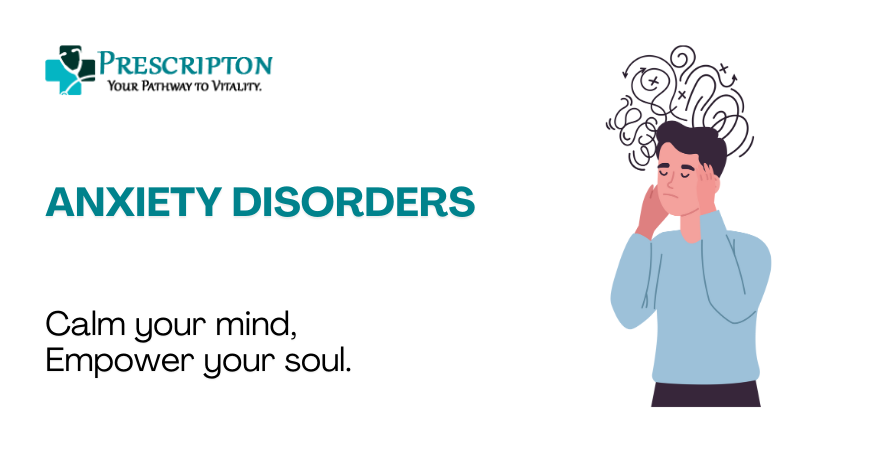
Understanding Anxiety Disorders: Symptoms and Solutions
Anxiety disorders are among the most common mental health conditions worldwide. While everyone experiences anxiety at some point in their life, anxiety disorders are characterized by chronic and excessive fear, worry, or nervousness that can disrupt daily life. In this blog post, we’ll explore the different types of anxiety disorders, their signs and symptoms, and some effective solutions for managing them.
What Are Anxiety Disorders?
Anxiety disorders encompass a range of mental health conditions that cause excessive fear and worry. Unlike normal anxiety, which is a temporary response to stress or danger, anxiety disorders are persistent and often disproportionate to the situation. These disorders can affect anyone, regardless of age or background, and can be caused by a combination of genetic, environmental, and psychological factors.
Types of Anxiety Disorders
Anxiety disorders come in various forms, each with its own unique characteristics. The most common types include:
- Generalized Anxiety Disorder (GAD): GAD is marked by excessive worry about everyday life events. People with GAD often find it difficult to control their anxiety and may experience physical symptoms such as muscle tension, restlessness, and difficulty sleeping.
- Panic Disorder: Panic disorder involves recurrent panic attacks, which are intense periods of fear or discomfort that peak within minutes. Symptoms include rapid heart rate, sweating, trembling, shortness of breath, and a feeling of impending doom. Panic attacks can occur unexpectedly and without an obvious trigger.
- Social Anxiety Disorder: Also known as social phobia, this disorder is characterized by intense fear of social situations or being judged by others. It can lead to avoidance of social interactions and significant distress in everyday activities like public speaking or meeting new people.
- Specific Phobias: Phobias are intense fears of specific objects or situations, such as heights, spiders, or flying. These fears are often irrational, but they can cause significant distress and avoidance behaviors.
- Obsessive-Compulsive Disorder (OCD): OCD involves intrusive thoughts (obsessions) that lead to repetitive behaviors (compulsions). Common compulsions include hand-washing, checking, and counting. These behaviors are performed to reduce anxiety but can become disruptive to daily life.
- Post-Traumatic Stress Disorder (PTSD): PTSD can develop after experiencing or witnessing a traumatic event. Symptoms include flashbacks, nightmares, hypervigilance, and avoidance of reminders of the trauma.
Signs and Symptoms of Anxiety Disorders
While each anxiety disorder has unique features, there are some common signs and symptoms to watch for:
- Physical Symptoms: These can include rapid heart rate, sweating, trembling, muscle tension, dizziness, and gastrointestinal issues.
- Emotional Symptoms: Feelings of fear, nervousness, restlessness, irritability, and a sense of impending danger.
- Behavioral Symptoms: Avoidance of certain situations, compulsive behaviors, and difficulty focusing on tasks.
Solutions for Managing Anxiety Disorders
Managing anxiety disorders often requires a combination of approaches. Here are some effective solutions for reducing symptoms and improving quality of life:
- Therapy: Cognitive-behavioral therapy (CBT) is one of the most effective treatments for anxiety disorders. It helps individuals identify and change negative thought patterns and develop healthier coping strategies.
- Medication: Antidepressants and anti-anxiety medications can be prescribed to help manage symptoms. Medications should be used under the guidance of a healthcare professional.
- Lifestyle Changes: Regular exercise, a balanced diet, and sufficient sleep can have a positive impact on anxiety levels. Mindfulness practices like meditation and deep breathing exercises can also help reduce stress.
- Support Networks: Connecting with friends, family, or support groups can provide valuable emotional support. Sharing experiences with others who understand what you’re going through can be comforting.
- Stress Management: Learning effective stress management techniques, such as time management, relaxation exercises, and setting boundaries, can reduce the impact of stress on anxiety levels.
Conclusion
Anxiety disorders can be challenging, but they are treatable with the right support and resources. If you or someone you know is experiencing symptoms of an anxiety disorder, seeking help from a mental health professional is an important first step. Remember, you don’t have to face anxiety alone—there are many effective solutions available to help you lead a happier and more balanced life.
